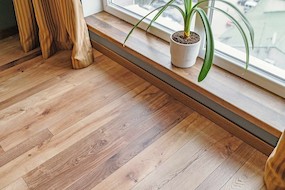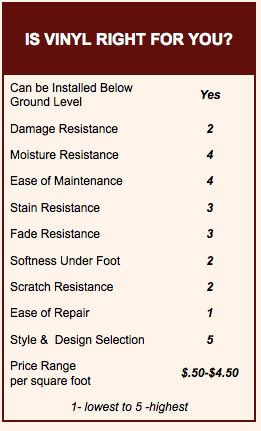Vinyl Flooring/LVT/LVP
LVT/LVP
Luxury Vinyl Tile (LVT) and Luxury Vinyl Plank (LVP) floors are 100% waterproof making it a great flooring choice for families with children & pets. LVP is luxury vinyl flooring that looks like wood planks in everything from color to species. Styling innovations such as surface textures often include the look of scraping or embossing, which dramatically heightens realism. Like wood, planks can be installed in various ways such as in brick fashion, diagonally, and so on. The enhanced bevels add to the beauty while an attached cork/hi-density rubber backing makes these floors warmer, quieter, and softer.
Advantages of LVT and LVP are that both LVT and LVP floors are constructed from layers of plastic, so they're waterproof, making them an ideal flooring choice for any room in your house, especially kitchens, bathrooms, and basements. LVT and LVP floors are designed to withstand moisture, heavy foot traffic, and plenty of scratches and spills. LVP/LVT flooring may be a better choice than hardwood flooring for your home.
LVT is a great option for anyone that is in search of a tile look. LVT will be a warmer choice over traditional ceramic flooring plus a much quieter & softer option.
WPC
WPC stands for wood-polymer composite or wood-plastic composite. WPC vinyl flooring is extraordinarily durable and known for its gorgeous, realistic aesthetic. It is a blend of wood fiber, wood flour and thermoplastics. The WPC boards are also prepared from inorganic fillers and plastic composites. Wood plastic composite is also used as a strong and high-end flooring option. Using advanced technologies, manufacturers can beautifully mimic the look of natural wood and stone at a lower price point.
Advantages of WPC are that it is a promising and cost-effective substitute for plywood, and is highly fire-resistant, boards are huge and long-lasting and thus, can be used for wood paneling. It is used for indoor and outdoor wall paneling.
So if you’re looking for the best wood flooring for pets, or in a mudroom that can stand up to water. WPC is a great option.
SPC
SPC stands for stone-polymer composite. Offering an unprecedented combination of design, simple installation, livability, and durability. An embossed thermo-resin layer provides stunning realism and integrated grout lines are perfectly coordinated, without making a mess. The rigid, hand-formed mineral core and cork underlayment dampen footsteps, while making the floor warmer and more comfortable underfoot than traditional tile.
The advantages of SPC are that it can go just about anywhere. That’s because SPC flooring is strong enough to be installed almost anywhere inside or outside of your home based on the climate. It is also incredibly durable. SPC is the most durable LVP currently on the market. SPC is always a great choice for families with kids, and pets.
If you are concerned about denting or scratching SPC might be the option for you.
Subflooring
Before you can begin your installation, you’ll need to prepare the subfloor. This process varies depending on whether you have a concrete or wood subfloor in place. You can also install luxury vinyl flooring over some existing floor materials.
Here are some steps to help prep a concrete subfloor.
1) Test the moisture content. If the flooring comes up easily, you’ll need to reduce the moisture content of the room via de humidification and repeat the test.
2) Thoroughly clean your subfloor. To ensure all debris is removed.
3) Make sure your subfloor is level.
4) Level your floor if needed.
Here are some steps to help prep a wood subfloor.
1) Cover your existing subfloor area where new vinyl flooring will be installed with 1/4-inch plywood.
2) Place your plywood pieces so their joints don’t go directly over the joints of your wood subfloor. Leave a 1/4-inch expansion gap around walls and joints.
3) Secure your plywood pieces in place using 1-inch decking screws.
4) Use appropriate floor patching compound to fill in the areas over screw heads.
5) Clean your floors thoroughly to ensure no debris remains.
If you are considering SPC. It can be very rigid, so any unevenness in the subfloor will be visible through the planks.
If you are considering WPC. WPC has more “give” to it, so it’s less likely to show imperfections in the subfloor.
Can I Install Luxury Vinyl Over an Existing Floor?
It is possible to install luxury vinyl flooring over an existing floor to save both time and money. Vinyl material that’s in place, as well as tile flooring, are generally the easiest to work with. In many cases, a new installation without removing your existing floor is possible, but the process is somewhat different.
How to prepare your floor will also depend on the existing material you have.
1) Your existing floor needs to be as clean as possible. Use an appropriate household cleaner. You may want to repeat the cleaning process more than once.
2) You’ll need to fill cracks between existing vinyl flooring materials with patching compound. Cement-based mixes work best for leveling grout lines when dealing with existing tile floors. Sand these areas to ensure a smooth, level surface all over.
3) Moisture content matters when installing luxury vinyl flooring over existing materials. While your set floor is likely to be dry, patching compound and cement-based mixes must also adhere to moisture requirements. Use a moisture meter or perform the 72-hour tape test with a piece of your new vinyl flooring.
Come in, contact us, or call (517) 546-0001 to receive expert assistance with your flooring needs today!
We serve Livingston County and all of Southeast Michigan including Howell, Brighton, Hartland, Pinckney, Fowlerville, Fenton, Linden, Highland, South Lyon, Ann Arbor, Flint and the entire Metro Detroit area.





